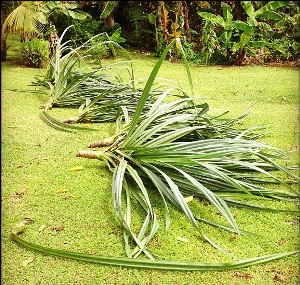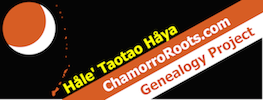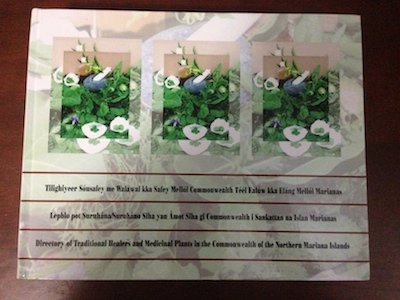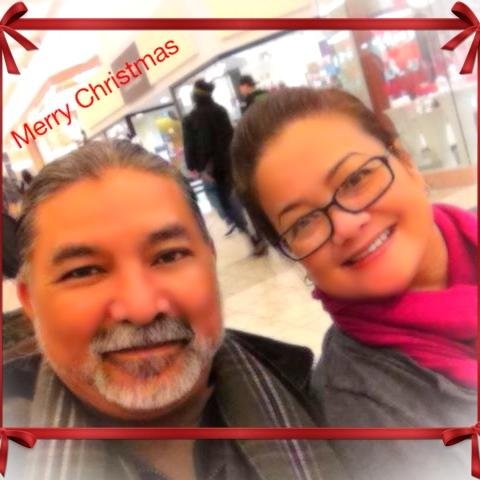Home
Akgak Weaving: A 1937 Glimpse
- Details
On November 27 2013, I wrote about the "Data on Chamorro Weavers ." That article primarily served as my initial observation of data contained in the 1920, 1930 and 1940 Census, and in the event anyone or even I would have a future interest in researching more about this component of our history and heritage.
Recently, I came across a 1937 article, "Akgak Weaving," from the Guam Recorder that was written by Ana P. Torres. It provided me with a little more insight about the åkgak and additional information for that particular period and so I made a copy of that 1937 article to share with everyone.
Tronkon Åkgak / Åkgak Tree
If you’re like me, I wondered what the åkgak tree look like. Below is a picture of James Bamba and åkgak that he posted on flickr. According to James, the “Tronkon åkgak, or Pandanus tectorius, the local pandanus cultivar planted on Guam for weaving. Propagated by cuttings as the plant isn't reported to fruit or flower. These trees are almost three times as tall as I am.” In the second picture, he was staging these cut stems of åkgak for replanting. I think it’s really cool with what he was doing with these and the many other Chamorro art products he produces every now and then.


According to Ms. Torres article, it is believed that the åkgak may have come from India many centuries ago, where it is primarily cultivated. Among the many weaved uses of the åkgak:
“The dried leaves, when picked and stripped of their rigid spiny keel, are used either in this form or twisted together to lash or secure the framework of houses and thatched roofs.
For weaving mats and large bags, the dried leaves are picked, the spines stripped off and each leaf is rolled and kept in this state for a period of three days. The purpose of the roll is to stretch the leaf.”
“…For weaving small bags, baskets, mats, cigarette cases and other fine work, the young green leaves are picked, steeped in boiling water for two minutes, scraped of their spines, and dried in the sun.”
Si’i (Weaving Tool)
The article also mentions the “si’i,” which is a weaving tool. I found this next picture of the si’i from Peter Toves’ “Chamorro Traditional Tools,” presentation.

Maria L. Mesa & the Weaving Club of Merizo
It was also interesting to note that Mrs. Maria L. Mesa of Merizo was a catalyst for inspiring people with the benefits of derived from manufacturing weaved åkgak products. She even organized a weaving club in Merizo in hope of others villages and people would follow suit.
Guam Åkgak Shop
Also in 1937, there was a sufficient amount of manufacturing weaved products to open the Guam Åkgak Shop at the Island Market Building. The Shop was open from 3:00pm to 5:00pm and on each Saturday from morning to noon. “A large assortment of luncheon sets, coasters, cigarette cases, bridge sets, purses and baskets of all descriptions are available.”
Does anyone recall or know exactly where the Island Market Building was located?
Today’s Weaving Opportunities
I would be curious to know what weaving efforts exist today in our islands that contribute to the economy. Although a lot of effort and labor is involved, weaving does remain an economic opportunity for those willing to make a go of it.
I would imagine many tourists would be willing to purchase weaved products as their authentic souvenirs and memoirs of our islands and culture.
I would also imagine that these products would be priceless for those of us abroad and to proudly display a part of our heritage.
Hafa mahon? Hafa hinasson-mu? What do you think?
Database Update 15 January 2014
- Details
Thanks for your patience. The database has been updated and has grown from 306,393 to 307,563 names.
Save the Date for Lukao Fuha
- Details
JOIN IN AS WE REMEMBER AND CELEBRATE LIFE AND REVIVAL OF AN ANCIENT TRADITION.
LUKAO FUHA- A Procession to Fuha! This location is sacred in our origin story of Fo'na and Pontan. Also, it was an ancient annual tradition of our Taotao Håya (Chamorro) ancestors and families from all the islands would be represented to make their way down to Guam to participate in the celebration of Fo'na (Fu'una) yan Pontan (Puntan).
For more information contact Joseph Certeza (671) 486-1589 or visit Our Islands Are Sacred on Facebook.
Suruhåna, Suruhåno yan i Amot
- Details
"Directory of Traditional Healers and Medicinal Plants in the Commonwealth of the Northern Mariana Islands"
By Manuel Flores Borja & Jose Somorang Roppul
"No law shall be made...prohibiting the traditional art of healing." From Article I, Section I of the Constitution of the Commonwealth of the Northern Mariana Islands. This is quite a profound statement that demonstrates a valuable component and deep respect of culture by embedding it within the supreme law of the land of the peoples'.
Although I have had this book for nearly a year, not long after it arrived, I loaned it out to a friend who was interested in it. So recently, it was returned and I have not quite finished reading it in detail, but did want to share with you the 47 names of people featured as a Suruhåna or Suruhåno in this book. Afterall, that is the main essence of the Chamorro Roots Genealogy Project – archiving names of those with Chamorro ancestry.
I am proud to say that Che'lu Noel Borja Quitugua, provided the design of the book cover. I must say that in the short time I have come to know Noel, I am quite inspired by his knowledge and efforts to help educate others and promote our culture.
This is an unusual and amazing book in so many ways of value and in addition to documenting part of our culture and history. It is translated in Carolinian, Chamorro and English. It contains oral history, many names and some with some genealogical information! Not all these people named are of Chamorro descent; however, this listing is inclusive and serves as a cross-reference for my genealogy notes.
This book also provided me more information about our connections and relationship with the Carolinians that have made our islands their home over the past few hundred years. It also contains some proverbs such as:
Chamorro: "Respeta I manåmko' sa' siha fondasion i lina'lå-ta."
Carolinian: "Awóór tuufey bwe iir lóngol malawasch."
English: "Respect the elders for they are the foundations of our lives."
I also didn't realize how many relatives through my Anderson lineage and within the Tudela branch, were traditional healers. This book was definitely calling out and talking to me!
FYI... As of this writing, I had extracted over 263 names and still counting!
Alphabetical List:
| Aguon, Mrs. Victoria (Vicky) Borja
Aldan, Maria (Tan Maria) Ayuyu Atalig, Margarita (Ita) Songao Ayuyu, Edward (Eddie) Aldan Ayuyu, Emilio Aldan Blas, Fermina Ogo Borja, Florencia (Chencha) Manibusan Borja, Teresita (Terry) Santos Calvo, Julita Atalig Camacho, Luis (Ling) Blanco Castro, Rodrigo (Digo) Mundo Castro, Rosa Tanin Castro, Thomas Castro, Vicente Cepeda, Luis Cruz Concepcion, Ignacio Salas Crisostomo, Maria Palacios Cruz, Jose Pangelinan Dela Cruz, Juana Santos Kapileo, Juan Quitugua Kioshi, Caridad Ogo Magofna, Trinidad Pinaula Manglona, Lourdes Toves Masga, Dolores Evangelista |
Mendiola, Beata Duenas
Mendiola, Donald Benavente Mendiola, Thomas Duenas Mesngon, Maria Mettao, Magdalena Lairopi Mundo, Jesse Salas Norita, Rebecca Maratita Omar, Tony Pialur Quitugua, Lucia Babauta Rangamar, Carmen Cabrera Rangamar, Rafael Ilo Reyes, Brigida Cepeda Roppul-Warakai, Rosa Somorang Sablan, Aguida Pangelinan Sablan, Gregorio P. Salalila, Rosa Blas San Nicolas, Henry Deleon Guerrero San Nicolas, Timothy M. Saralu, Dionisia Saures Seman-Riumd, Marina Laniyo Sulapas, Remedio Camacho Toves, Carmen Matagolai Tudela, Conception Faiso |
Coincidently, last week the Mina dos na Konferension Amot was held on Guam from January 2-4, 2014. Kudos to Ursula Herrera, Jessica Nangauta and the many others who made this event possible and sharing the information and pictures on FB.
Some additional reading information on-line regarding suruhånos and suruhånas (traditional healers and medicine):
Paula Brinkley. 1999. Use of Traditional and Alternative Medicine in Children on Guam, Volume 6, No. 2, pg. 168-177.
Chamorro Language & Culture. 2008. The difference between being a Suruhana, Le'an, and using Atgimat. Retrieved January 2, 2014 from: http://chamorrolanguage.blogspot.com/2008/04/difference-between-being-suruhana-lean.html
Hale'ta Series, Department of Chamorro Affairs, ' Suruhånu yan Amot: Healers and Medicine', referenced January 2, 2014, © 2009 Guampedia™, URL: http://guampedia.com/healers-and-medicine-suruhanu-yan-amot/
Påle Eric Forbes. 2012. More on Chamorro Medicine. From: http://paleric.blogspot.com/2012/09/more-on-chamorro-medicine.html
Guam Community College. 2013. The Medicine of the Ancient People (Chamorro Language video with English subtitles. Retrieved January 2, 2014 from: http://i-nasion-chamoru.blogspot.com/2013/06/the-medicine-of-ancient-people.html
Marilyn C. Salas, PhD, ' Ancient Chamorro Medicine Making', referenced January 2, 2014, © 2009 Guampedia™, URL: http://guampedia.com/ancient-chamorro-medicine-making/
Page 58 of 84




